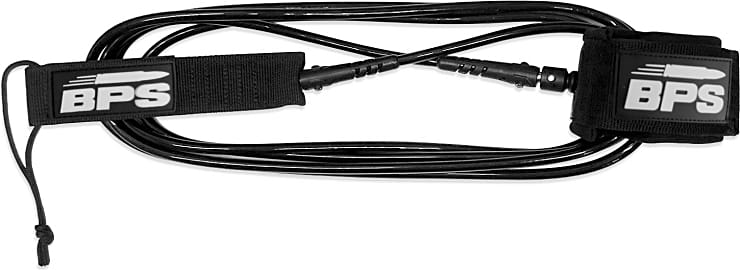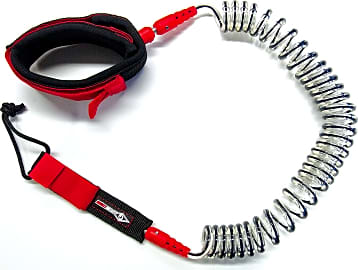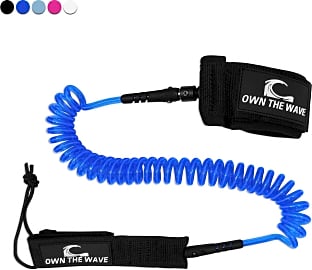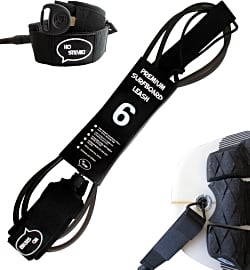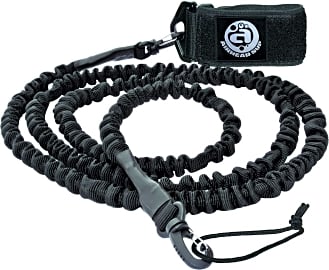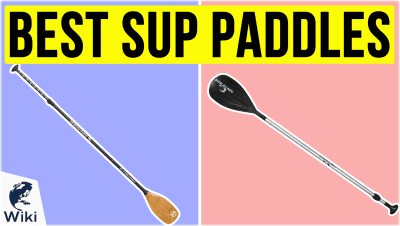The 9 Best SUP Leashes

This wiki has been updated 37 times since it was first published in April of 2016. Whether you are just getting into stand-up paddleboarding or have been enjoying it for a long time, a high-quality leash is a vital piece of equipment to keep on you at all times. Something from our comprehensive selection will ensures your expensive board doesn't go floating away if you fall off. We've included models suitable for replacing a damaged one or upgrading one that came with your SUP. When users buy our independently chosen editorial recommendations, we may earn commissions to help fund the Wiki.
Editor's Notes
July 01, 2020:
SUP leashes may seem like a basic, if vital, piece of equipment, but the truth is that small details can really make a difference in how they perform. For example, coiled models like the Dakine Coiled Calf, Retrospec Helix, Bic Sport Coil, and Own the Wave Premium 10-Foot are great because they tend to stay on your board, rather than dragging in the water behind you, which should make paddling more efficient since their isn't anything slowing you down.
On the other hand, some riders don't like coiled models because they feel it hinders their leg movement a bit. If you fall into this group, you'll prefer a straight leash like the BPS Storm, Dakine Straight 6675200, and Ho Stevie! Premium Surf. Of these, the Dakine Straight 6675200 is the longest, at 12 feet, so it offers the most amount of freedom, while the Ho Stevie! Premium Surf is the shortest, at just nine feet, which means it is less likely to get tangled up.
The Airhead Scrunchy stands apart from the rest with a stretchy elastic cord that is covered by a fabric webbing. While the cover adds to its overall durability, it can become a detriment if the leash winds up in the water, since it can cause a lot of drag.
If you don't bring along a dry bag when you ride, and are worried about having somewhere to stash your key, you should consider the Ho Stevie! Premium Surf and BPS Storm, both of which have small pockets integrated into the cuff.
For those who tend to drop their paddle often, we have included the YYST Paddle Leash. We are of two minds about this one. Some may find it can get in their way, which is something we certainly understand, but on the flip side, you really don't want to get stuck out in the water without your paddle to help you get home, so it may be worth using if yours doesn't float.
Special Honors
StarBoard Surf Leash Made from a soft, cushioned material that is, nevertheless, quite durable, the StarBoard Surf Leash flattens out when you step on it, which causes significantly less discomfort than when stepping on a traditional one. Plus, the cuff is made from a natural rubber that has a smaller carbon footprint that neoprene, which is what many other companies use. star-board.com
A Brief History Of Stand-Up Paddleboarding
The act of standing up and paddling a watercraft dates back thousands of years.
The act of standing up and paddling a watercraft dates back thousands of years. There are references to it in the histories of many cultures, including Polynesian, Chinese, Peruvian, and African. Some stories say that the Egyptian pharaoh’s daughter Queen Bithia was standing up and paddling a small boat along the Nile when she spotted Moses floating in the basket. More than likely, the practice began when fisherman in canoes began standing up to better spot and spear prey. Standing in the canoes also allowed the fishermen to paddle more smoothly, thereby minimizing the chances of spooking the fish.
While stand-up paddling definitely has a long history as a method of better fishing, the act as a leisure activity is much more recent. Though it is impossible to establish exactly when this started, we do know that by the 18th century it was firmly entrenched in the Polynesian culture, often being depicted in their artwork. James King, who was tasked with finishing Captain Cook's journals, mentioned encountering it in 1778, when the HMS Discovery and Resolution made the first recorded European visit to Hawaii. This indicates that the roots of the sport in its current form is traceable back to Polynesia at some date before that.
Sometime between 1950 and 1970, Hawaiian surfers started using stand-up paddleboards as a way to stay in shape throughout the off season when the waves weren't intense enough for traditional surfing. Despite there being a burgeoning recreational surf culture by this time, interest in riding the large and stable paddleboards as a hobby in their own right didn't begin to take hold until the last decade of the century. Before that, they were often just seen as vessels that could be used to take surfers out to catch large breaks on their smaller, more responsive boards or as training aids.
The efforts of a variety of organizations and individuals are responsible for bringing stand-up paddleboarding to mainstream culture. First, surf schools in Hawaii started teaching it as a way to surf when there were little or no swells. As this practice become more popular, Brian Keaulana, a well-known surfer, decided to add it to the Buffalo Big Board Contest in 2003. In California, we can thank the organizers of the Waterman Race and the Catalina Classic for creating paddleboard races, helping to bring more awareness to the sport. Since coming to the mainland, the SUP popularity has skyrocketed, and it is no longer just for individuals who identify with the surfer culture.
What Exactly Makes Stand-Up Paddleboarding So Popular
These days, everyone from yogis to fishermen and outdoor enthusiasts can all be seen making use of SUPs. It's not hard to figure out why either. There a number of reasons why the sport is becoming so popular. Stand-up paddleboards can be used on almost any body of water. Unlike traditional surfboards, which require breaks, SUPs can be used on calm lakes, small creeks and rivers, lagoons, and, of course, out in the ocean. This means you don't need to live by the sea to enjoy one. Age also isn't a deterrent. It is a low-impact activity that is extremely safe for the old and young alike. Add to that the fact that it burns a lot of calories in an enjoyable way, and you have a great way for anybody to lose weight, without having to spend time laboring away in the gym. Regular stand-up paddleboarding will also increase your core, back, arm, and leg strength, as well as improve your coordination, making it great for full-body conditioning.
Many areas have SUP groups and meetups that are often free to join.
Depending on how you prefer to spend your time, stand-up paddleboarding can either be a social activity or a solitary one. You can spend time alone, paddling in the great outdoors as a way to clear your mind and let the stress of your daily life melt away, or you can go along with a group of friends, chatting and enjoying the day together. Because these large boards are so stable, you can even bring your dog along for the ride, of course we recommend you dress them in a doggy life jacket to ensure their safety.
Since there are SUPs and SUP accessories available in a variety of price ranges, it can be a very affordable sport, too. From affordable beginner packages that include everything you need to expensive racing boards and paddles, there should be something to fit everyone's needs and within anyone's budget. Stand-up paddleboarding is also a great way to meet people and make new friends. Many areas have SUP groups and meetups that are often free to join.
Choosing The Best SUP Leash For You
Each type of SUP leash has its own set of pros and cons, making each better suited to a particular riding style and condition. Coiled leashes are nice because they don't drag in the water as you ride, which makes them ideal for racers, and anybody else who likes to cruise as fast as possible. They are also very good for flatwater paddlers and those who often walk around on the board while they ride, for whom a straight leash might get tangled up around their feet.
The downside of coiled leashes is that they have tendency to ricochet the SUP back at the rider if they fall hard away from the board. This means they aren't great in fast water scenarios, as this is where hard falls are more likely. If you do like to surf the breaks, then a straight leash is the safest option, as it won't cause the board to ricochet, and any drag in the water will be essentially unnoticeable.
When choosing a leash, you should purchase one that is about one foot longer than your board when it is fully extended. For any leash you choose, it is usually best not to go less than 6mm thick, though if you will only do flat water paddling and don't have a very large or thick board, it may be okay to go just a little thinner.



